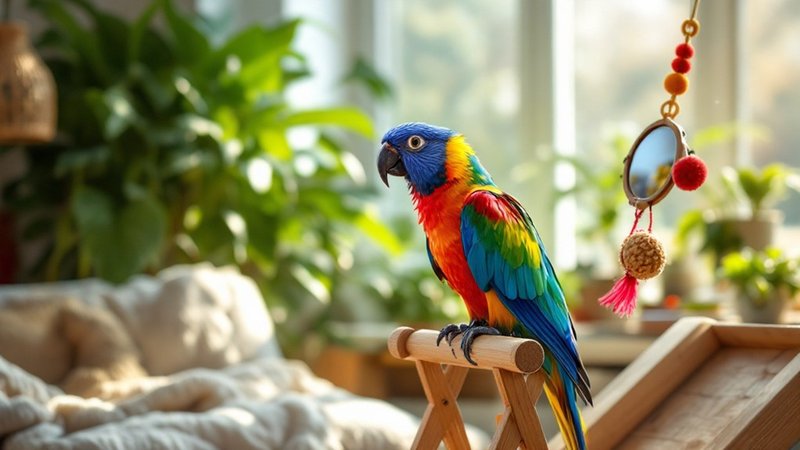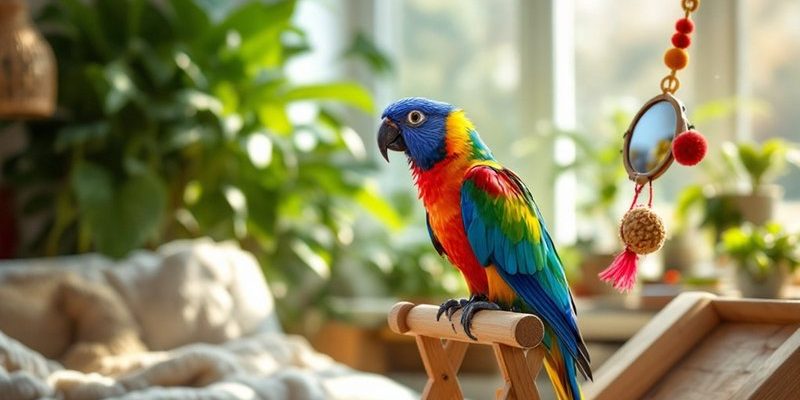
To get started, you’ll need to understand the unique nature of parrots. They are highly social creatures, so they thrive on interaction and communication. Just like how we develop friendships over time, your bond with your parrot will grow through trust and shared experiences. Whether you have a budgie, an African grey, or a cockatoo, this guide will show you how to create a loving and harmonious relationship that enriches both of your lives.
Understanding Your Parrot’s Behavior
Before you can bond with your parrot, it’s essential to understand their natural instincts and behaviors. Parrots are intelligent and curious, which means they love to explore their surroundings and interact with their companions. Sometimes, this curiosity can lead to mischief. For instance, they might chew on furniture or decide that your favorite plant looks like a tasty snack.
Parrots also experience a wide range of emotions. They can feel anxious, excited, or even jealous. You might notice your parrot becoming nippy or loud when they need more attention. It’s crucial to recognize these signs so you can respond appropriately. Remember, spending time watching your parrot can provide valuable insights into their personality and needs.
Having a deep understanding of your parrot’s behavior not only helps in training but also enhances your bond. When you learn to read their cues, you’re better equipped to meet their needs, which fosters trust and companionship.
Creating a Safe Space
Your parrot’s environment plays a massive role in how comfortable they feel around you. Start by creating a safe and inviting space where your feathered friend can relax and explore. This means providing a spacious cage that mimics their natural habitat, complete with perches, toys, and opportunities for mental stimulation.
Also, think about the layout of your home. Parrots are more likely to feel secure if they have a consistent spot to hang out. Consider placing their cage in a people-friendly area but away from loud noises or strong drafts. This way, they can observe the world without feeling overwhelmed.
Lastly, ensure that all potential hazards are removed. Common items that can pose a risk include toxic plants, small objects they might swallow, and wires they can chew on. A safe environment leads to a happy parrot, and a happy parrot means a stronger bond with you.
Building Trust Through Interaction
Once your parrot feels safe, it’s time to build trust through regular interaction. Start by simply sitting near their cage, speaking softly, and allowing them to get used to your presence. You might feel a bit silly talking to a bird, but trust me, they appreciate the chatter!
After a few days, you can try offering treats. Use healthy snacks like sunflower seeds or small pieces of fruit to create positive associations with your presence. You might say, “Come here, buddy!” as you offer the treat, which helps them connect your voice with something enjoyable.
Gradually, you can open the cage door and let them come out on their terms. Be patient—some parrots might take longer than others. This slow approach allows your parrot to feel in control, making them more likely to build a trusting bond with you.
Positive Reinforcement Training
Training your parrot through positive reinforcement is one of the most effective ways to bond with them. This means rewarding them for good behavior—whether it’s stepping onto your hand or mimicking a sound you make. Use treats, praise, or even a gentle scratch on the head when they do something right.
Start with basic commands like “step up” or “come here.” To teach the “step up” command, hold your finger out in front of your parrot and gently coax them to step onto it. Remember, patience is key here! If they refuse, don’t force them; instead, try again later.
As your parrot masters these commands, you can introduce more complex tricks or behaviors. It’s essential to keep training sessions short and fun. This keeps your parrot engaged and excited, reinforcing the bond between you.
Understanding Parrot Body Language
Just like we communicate with words, parrots have their own way of expressing emotions through body language. Learning to interpret these signals can significantly improve your relationship with your bird. For example, if your parrot is puffing up their feathers, they might be feeling relaxed. However, if they’re flapping their wings or bobbing their head aggressively, they could be agitated.
Another sign to watch is whether your parrot is leaning toward you or away. Leaning in usually shows interest or affection, while leaning back could indicate fear or discomfort. Pay close attention to these cues and respond accordingly. If they seem nervous, give them space and try approaching again later.
Understanding your parrot’s body language deepens your connection and helps you respond appropriately to their needs, creating a more harmonious living environment.
Socialization with Family and Friends
Socializing your parrot with family and friends is an excellent way to enhance their confidence and enrich their life. Introducing new people can be a bit tricky, though, especially if your parrot is shy or feels territorial. Start by having friends or family members sit quietly near the cage, allowing your parrot to observe them from a distance without feeling pressured.
Once your parrot feels comfortable, encourage visitors to offer treats and gentle words. This method helps your parrot associate new people with positive experiences. You might find that your parrot becomes more outgoing over time, showing off their vibrant personality.
Keep in mind that not every parrot will respond the same way to new people. Some may take longer to warm up, while others might be eager to socialize right away. Be patient and respectful of your bird’s comfort level to ensure positive interactions.
Keeping the Bond Strong
After establishing a solid relationship, it’s essential to maintain that connection. Spend quality time with your parrot daily. This doesn’t always have to involve training; sometimes, simply hanging out and letting them play is just as valuable.
Consider diversifying their activities to keep things exciting. Try introducing new toys, rotating them regularly to spark curiosity. You can also set up playdates with other birds, which can be beneficial for socialization and mental stimulation.
Above all, remember to be flexible. Each parrot has its own personality and needs, so honor those quirks and preferences. Celebrate milestones, whether big or small, and cherish the journey of taming and bonding with your unique feathered friend.
In the end, building a relationship with your pet parrot is a rewarding experience that requires time, patience, and love. By understanding their behavior, creating a safe space, and using positive reinforcement, you can foster a strong bond that brings joy to both of your lives. Your parrot will not only feel secure but also thrive in a nurturing environment that encourages their playful spirit. Enjoy the adventure!

